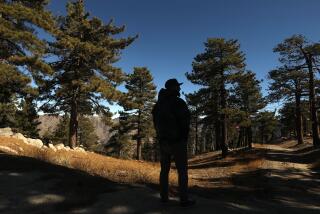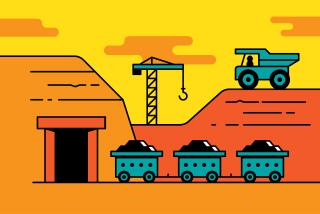Mining proposal maddens Duarte
The mountains that rise above their Duarte home have served as both backdrop and recurring character in the lives of John and Martha Jansen. On clear nights, John takes to the ridges with his telescope and amateur astronomy guides. Martha finds quiet inspiration for her oil paintings in the panoramic view of the peaks.
In summers past, the couple often took their six children on treks in search of the famed 80-foot, three-tiered waterfalls hidden in the mountainsâ ravines. A few years ago, one of their sons hiked up a trail with his girlfriend to show her the âmarry meâ poster atop his parentsâ roof.
So a mining companyâs proposal to shift operations to a ridge above Duarte has angered the Jansens, who are pained at the thought of another hillside being scarred by excavation work. And although the 80 acres of land in question are not visible from their home and are located in adjacent Azusa, they have joined hundreds of residents in protest of what they believe will lead to an increase in air pollution and a marred landscape.
âAzusa is our neighbor, and neighbors should really try to get along,â Martha Jansen, 66, said. âBut when it comes to the health of the children and the damage of the wildlife and plants that are native to the area, sometimes we have to fight for what is right.â
Mining has been woven into Azusaâs fabric since the discovery of gold in the 1850s at the fork of San Gabriel Canyon. The treasure of the canyons has since become hard granite that is crushed into aggregate used to construct highways and pave riverbeds.
The area that has the Jansens and others worried is at the mouth of Fish Canyon, where mining has been going on for decades, although not without complaint.
Azusa cleared the way for excavation in the canyon when it approved a 50-year mining permit in 1988. At the time, Duarte residents unsuccessfully campaigned to have the site closed. The latest proposal has again galvanized many in the bedroom community of 22,000.
::
Vulcan Materials, the company now on the site, wants to shift its operations so it can mine 80 acres that border Duarte. Vulcan originally planned to mine an eastern section of its 270 acres but says the land near Duarte is less visible, which is in keeping with Azusaâs General Plan.
The companyâs proposal also mandates concurrent reclamation of the hillsides using a technique called micro-benching, which allows for greater revegetation than the approach that Vulcan now uses, a method that leaves pyramid steps about 40-feet high and 25-feet deep. As it stands now, reclamation is not required until 2038.
Despite air quality and environmental reports that show the rock quarry will have no major effect on Duarte aside from aesthetics, many residents say that years of living near the mines have given them reason to worry.
During recent months, locals have flooded Azusa city meetings. At one session, a pro-Vulcan speaker was booed. During another, police were called to remove a Duarte resident who was told he couldnât make a PowerPoint presentation.
Duarte Mayor Margaret Finlay has been outspoken about her desire to rid the area of mining altogether. In February, she rode her bike to Azusa City Hall to drop off hundreds of letters protesting the proposal. She also raised the possibility of boycotting Azusa businesses.
âThis isnât about Duarte and Azusa,â the mayor insisted. âVulcan is not being a good neighbor and they are clearly trying to split our community. They ought to just pack up their marbles and go someplace else, not a valley that is beautiful and where people live because they love these mountains.â
Vulcan spokesman Todd Priest said some people appear to have lost sight of the issue: Itâs not whether mining will occur -- it will -- but where.
Under the proposal, Vulcan will have to reduce its mining by more than 4 million tons, a positive gain for residents that Priest said has been undercut by the political agenda of Duarte officials.
In January, the Duarte city manager sent a âconfidential settlement communicationâ to his counterpart in Azusa suggesting that the citiesâ jurisdictional boundaries be redrawn in light of the mining proposal. It essentially would have ceded several corners of Azusa to Duarte.
Francis Delach said no thanks.
Although future mining tax revenues for Azusa could range from $500,000 to $1 million annually and Vulcan donates to local organizations, including a program for at-risk children, Delach said the project is being weighed on its environmental merits.
âWeâre one of the few cities in the entire area where weâve not had layoffs or cut programs or services. We are not financially hurting,â he said. The true benefit to the city, Delach said, is the immediate reclamation of the hillsides.
Thatâs a bonus that Azusa resident Mercedes Castro, 58, said makes the proposal agreeable, especially since fighting Vulcan would take a costly lawsuit and do nothing for the already scarred hillsides.
âWe committed to it a long time ago,â said Castro, who owns a printing and promotions company. âWe should make the best of it.â
::
Some contend that the Vulcan property is blocking the real crown jewel of the area: the trail to Fish Canyon Falls, which boasts breathtaking waterfalls, bountiful wildlife and a sparkling creek.
Hikers complain that the family-friendly three-mile hike has been restricted by the mining. Vulcan currently provides a free shuttle across its property to the trail head, but its availability is limited and the only alternative is a longer, more rigorous high-altitude trail.
Grievances have also been made about dust and particles from the mining affecting an elementary school in the foothills. But Duarte resident Andy Dessoffy, 42, said Vulcan is not entirely to blame.
âJust living next to mountains you are prone to more dust,â said Dessoffy, who works in construction and has two young children. âFor the most part, the air seems pretty fresh back here. Itâs kind of like if you buy a house next to the airport you canât complain about the airport later, can you?â
But Jeanne Hart said she didnât know about the mining when she bought her home near Fish Canyon in 1993. Two years ago, the French teacher noticed she was having trouble breathing and was feeling pressure on her chest. Hart, 71, said sheâs been diagnosed with silicosis -- a disease caused by continued inhalation of mineral dust -- and believes the mining is responsible.
Richard Deem of Save Our Canyon, a group that opposes the mining plan, said it is Duarte that will suffer the brunt of a relocated mining operation.
âIn the past, the mountain has acted as a buffer because theyâre mining the other side,â he said. âUnder the new plan, theyâre going to be mining on the ridge that overlooks the city of Duarte, and if any dust is generated off there, the Santa Anas are just going to blow it directly into Duarte.â
More to Read
Sign up for Essential California
The most important California stories and recommendations in your inbox every morning.
You may occasionally receive promotional content from the Los Angeles Times.











